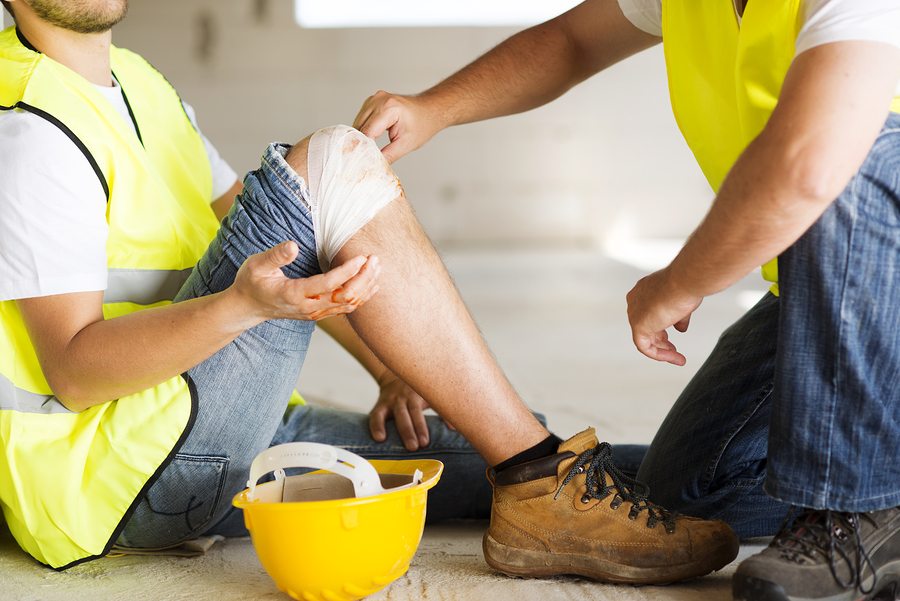Construction sites are notoriously dangerous. But there are precautions you can take to help minimize the risks of injury. Here are the Top Ten Safety Concerns you shouldn’t overlook:
1. Scaffolding
Providing extensive scaffolding training for any workers who will use it is essential. Not all workers automatically know how to use scaffolding. They must be taught about the dangers of power lines, unstable platforms and falling debris. Be sure any suspended or supported scaffolds have guardrails. Scaffolding must always be strong enough to support at least four times the intended load.
2. Ladder Safety
Ladders should be visually inspected before each use. Show employees how the check the side rails, rungs and feet for damage or defects. All ladders’ side rails should extend no less than three feet above the ground, and the top must meet a sturdy support. Educate employees about the dangers of ladder misuse. Ladders should only have weight loads that they’re designed to support. Be sure they also comply with the OSHA’s 29 CFR 1926.1053(a)(1) regulation.
3. Personal Protective Equipment
Most employees know this term simply as PPE. This equipment is essential for protecting employees from various hazards. Latex gloves are used when handling chemicals, dust masks are worn when sawing and earplugs are worn when using noisy tools. Hard hats and goggles are usually worn at all times to protect workers from dangerous falling or flying objects. OSHA requires employers to provide PPE when it is essential for the workplace. Construction sites are never an exception to this rule. Many employees find these accessories uncomfortable to wear. To prevent them from refusing to wear PPE, employers should offer comfortable equipment that specially made.
4. Confined Space Safety
Working in a small space may result in injury or death from being exposed to a toxic, combustible or oxygen-deficient atmosphere. Such spaces should always be connected to a reliable monitoring system. Employees exposed to the area should also be educated about the risks and how to identify them. Be sure to implement a Lockout/Tagout system to protect workers from unwanted starting of dangerous machines. To learn more about this system’s regulations, read the 29 CFR 1910.147 OSHA regulation. Compliance with this standard prevents approximately 55,000 injuries and 120 deaths annually.
5. Welding Safety
Eye injuries and burns happen to welders too often. These injuries may cause extended damage or permanent disfigurement. By making sure welding employees always wear the right PPE, this risk is reduced greatly. To prevent welders from refusing PPE, be sure their equipment is paid for, comfortable and fits properly. Be sure to provide them with flame-retardant clothing also. ANSI Z87.1 rules that helmets are essential. They are a secondary form of eye protection, so goggles or glasses must also be worn. It’s also essential to ensure there are fans or ventilation systems in place to reduce the risk of airborne hazards.
6. Fall Protection
In addition to providing fall prevention training, employers should conduct a test or review of employees’ knowledge. It’s important to ensure that they know how to prevent themselves from falling. Develop an efficient safety plan that includes a team effort.
Be sure to have fall protection equipment checked regularly. Observe it after each use for any apparent damage. In addition to this, have the equipment inspected and documented annually. Remember to keep OSHA regulations in mind for inspections and documentation.
7. Respiratory Safety
This safety issue is serious enough that OSHA developed many regulations about it. The types of chemicals, dust or other harmful substances that cause respiratory problems may vary from one work site to another. However, there are precautions that must be taken to avoid overexposure or accidental inhalation of a substance.
OSHA’s 29 CFR 1910.134 regulation details respiratory safety standards. Employers should always have a work site assessed by an occupational health specialist to determine the risk of exposure to harmful substances. In addition to this, contact a personal business insurance company to find out what their rules about harmful substance exposure are.
8. First Aid & Fire Safety
Since the risk for injuries is higher in the construction field, it’s essential for employees to know first aid. Show them how to use kits, how to treat common injuries and how to prevent infections. They should also be instructed to report their injuries, however small or large, to their supervisor. Show them how to use eyewash stations, burn kits and emergency drench showers. Be sure they know how to use a fire extinguisher and are familiar with evacuation plans. Conducting regular fire drills is a safety essential.
9. Proper Documentation
Not only is thorough documentation required by OSHA but it’s also required by the law. In the unfortunate event of injuries or fatalities, it’s imperative to have thorough documentation of everything. Investigations are common in legal proceedings, so having a lack of documentation may place an employer in a bottomless pit of problems. Always keep injury logs, work logs and employee injury records current.
10. Safety Training
Be sure to provide ample training for employees. Weekly safety meetings, monthly seminars and voluntary training classes should all be established. OSHA offers an outreach training program that is voluntary. To give employees the chance to complete it, contact OSHA to receive complete information about the program.



